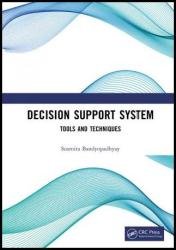 Название: Decision Support System: Tools and Techniques
Название: Decision Support System: Tools and TechniquesАвтор: Susmita Bandyopadhyay
Издательство: CRC Press
Год: 2023
Страниц: 395
Язык: английский
Формат: pdf (true)
Размер: 26.0 MB
This book presents different tools and techniques used for Decision Support Systems (DSS), including decision tree and table, and their modifications, multi-criteria decision analysis techniques, network tools of decision support, and various case-based reasoning methods supported by examples and case studies. Latest developments for each of the techniques have been discussed separately, and possible future research areas are duly identified as intelligent and spatial DSS.
This book aims at describing different tools and techniques in order to assist the decision making in all levels of management. There are various types of problems and therefore, variety of decisions to be taken – for example, allocation problem, classification problem, prediction problem, problems with huge amount of data (especially for present and future), network-related problems, complex problems with uncertainty, and so on. These problems can be solved using different techniques. For example, for allocation problems, Linear Programming (LP) algorithms can be applied; for prediction problem, regression of different types depending on the type of problem can be applied; for classification problem, decision tree or some other techniques are applicable; problems with huge amount of data can be handled by data warehousing techniques; for network-related problems, networking methods or methods like Petri net can be applied. Thus, different kinds of problems demand different kinds of analytical techniques. This book focuses on some very essential tools and techniques that can be applied in order to assist the decision-making process. Some of the techniques have been illustrated briefly, and some other techniques have been illustrated in details. Each technique has been explained with sufficient example or case study. The users are expected to get a good idea and learning for the tools and techniques as presented in this book.
The word ‘intelligence’ from machine perspective indicates the application of Artificial Intelligence (AI). In other words, it indicates the implementation of human intelligence in machines and related applications. In case of intelligent decision support system (IDSS), the purpose is to automate the decision-making process so as to imitate the human decision-makers. Thus, a significant number of tools and techniques can be mentioned for intelligent decision-making tools. This chapter mentions a few of those, namely, enterprise information system (EIS), which is discussed in brief; knowledge management (KM), which includes a significant number of nature-based algorithms that are basically based on different natural phenomena; Artificial Intelligence (AI), which discusses various aspects of it. However, the nature-based algorithms and many other techniques are also included as the techniques under AI. AI techniques include many other tools, techniques, and methods, such as, natural language processing. Some of these areas of AI have been briefed in this chapter. Besides, taking the smart technology under consideration as we are living in a smart age, some aspects of smart technologies such as cloud computing have also been introduced very briefly in this chapter.
Artificial Intelligence can be defined as applying human intelligence in machines and software systems. There are many components of AI, such as intelligence quotient, reasoning, learning, problem-solving, perception, and using language. However, the intelligence for computer can be logical intelligence, probabilistic intelligence, emergent intelligence, neural intelligence, or language understanding. The field of AI includes several concepts such as, Machine Learning, natural language processing (NLP), Deep Learning, expert system, artificial general intelligence, speech recognition, problem-solving, fuzzy logic, cognitive computing, and nature-based techniques. Searle said that AI can be strong or weak. Searle commented on Strong AI saying that – “the appropriately programmed computer really is a mind, in the sense that computers given the right programs can be literally said to understand and have other cognitive states”. “The proposition that computers could appear and behave intelligently, but not necessarily understand, is called weak AI”. This section discusses different components and aspects of AI in brief. The following section discusses propositional logic as a part of logical intelligence. The subsequent section is going to discuss different nature-based algorithms (genetic algorithm (GA), particle swarm optimization (PSO), ant colony optimization (ACO), artificial immune algorithm (AIA), differential evolution (DE), simulated annealing (SA), etc).
Features:
Discusses all the major tools and techniques for Decision Support System supported by examples.
Explains techniques considering their deterministic and stochastic aspects.
Covers network tools including GERT and Q-GERT.
Explains the application of both probability and fuzzy orientation in the pertinent techniques.
Includes a number of relevant case studies along with a dedicated chapter on software.
This book is aimed at researchers and graduate students in information systems, data analytics, operation research, including management and computer science areas.
Скачать Decision Support System: Tools and Techniques